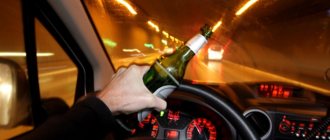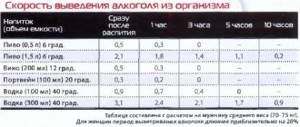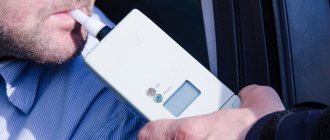Permille: what is it?
Permille is one thousandth of the content of a substance in something.
Therefore, the answer to the question, 1 ppm is how much alcohol, is quite easy to obtain: 1 liter of blood contains 1 g of ethanol.
When drinking drinks of different strengths, you should calculate this indicator, since it will vary. For example, 1 ppm - how much vodka? It is important to take into account the person’s weight and gender. The percentage of fluid in a man's body is 70, in women - 60. The average weight of a man is about 70-75 kg. So, after 100 g of vodka, that is, 40 g of alcohol, the alcohol level will be 0.55 ppm.
Permissible alcohol limit while driving in ppm
For three years, from 2010 to 2013, the permissible rate was “zero” ppm, which completely excluded the possibility of a dispute with traffic police inspectors. However, this norm had many drawbacks. Eating many foods moves the blood alcohol content above zero - chocolate and baked goods, kefir and kvass, juices, yoghurts and overly ripe bananas. Not to mention non-alcoholic beer or many medications.
In 2013, the effect of “zero” ppm was canceled. Now driving a car is allowed if the breathalyzer shows no more than 0.16 mg per liter of air . This is the new measurable threshold for intoxication. But ppm is a value that calculates the alcohol content in the blood, not in the air.
0.1 ppm, contrary to popular belief, is not equal to 1 mg/l. To calculate it, a formula is used in which 0.1 ppm contains exactly 0.045 mg/l of alcohol. After calculations, we find that the permissible maximum ppm for the current year is approximately 0.35.
The new standard has minimized the measurement error of the breathalyzer. How to determine the approximate ppm level in the blood after drinking alcoholic beverages?
Permille and car driver
If the alcohol content exceeds 0.3-0.6‰, the driver is considered to be drunk. An error in the dose is needed for people who do not drink, but take medications, have specific gastrointestinal diseases, and those who consume some of the products described above.
If the driver’s drunken state is confirmed, sanctions are immediately applied to him: if the violation is the first, then it is a fine of 30,000 rubles and deprivation of rights for a period of 1.5-2 years; if the violation is repeated, more stringent measures follow.
Permitted ppm level for driving a car
According to the current legislation in Russia, drivers are allowed to drive a car if the permissible limits of alcohol detected in the blood do not exceed the permitted deviation.
One liter of exhaled air should contain no more than sixteen hundredths of milligrams of alcohol (ppm). In blood this threshold is 0.35 ppm.
Features of the concentration of ppm alcohol in the blood in men
If we consider the ppm mark according to the severity of intoxication, then the percentages mean:
- 0.3 – within the statistical error. The person being tested is sober, and the presence of a small amount of ppm does not exceed the established measurement error;
- from 0.3 to 0.5 – slight intoxication. Driving a car is prohibited due to impaired physiological reflexes;
- from 1.5 to 2.5 – corresponds to an average degree of intoxication;
- over 3 – strong degree.
A reading greater than 5 percent is the maximum blood alcohol content indicating a lethal dose.
In men, due to physiological characteristics, alcohol is absorbed faster compared to women. After an hour from the moment of consumption, the amount of ppm will decrease to 0.17 percent.
To achieve the level of one ppm, a man with average body weight and health characteristics can drink up to five hundred grams of a drink with a strength of up to forty degrees.
Features in women
The permille limit permissible for driving a car does not differ by gender. But for women to achieve a ppm level similar to men, they need to drink much less with a similar control result:
- cognac, vodka or beer - in a ratio of three to five (not in favor of the weaker sex);
- wines and other low-alcohol wines - half as much.
Alcohol also disappears much more slowly in women. An hour after drinking, the ppm level will decrease by only one tenth of a percent.
The legislative framework
There are a number of legal acts that traffic police officers and drivers are guided by:
- Federal Law No. 528 – changes in legislative acts on increasing driver responsibility.
- Federal Law No. 63 is stated in the Criminal Code of the Russian Federation.
- Decree of the Government of the Russian Federation No. 1090, establishing traffic rules.
- Federal Law No. 195 is spelled out in the Code of Administrative Offences.
Violation of current legislative norms leads to administrative or criminal liability in the form of fines, deprivation of a driver's license, and imprisonment. In 2021, bills are being considered that could increase the punishment.
Refusal to undergo a medical examination is equivalent to an admission of guilt and, therefore, entails punishment.
Stages of intoxication and their manifestations
- Mild degree – 0.5-1.5‰. Feeling of discomfort, mild disturbances in speech and motor functions. Excitement, partial loss of self-control.
- The average degree is 1.5-2.5‰. Decreased activity, monotonous speech, dulled sense of danger, and significantly impaired coordination of movements.
- Strong degree – 2.5-3‰. Inadequacy of behavior and assessment of the situation, severe disturbances in the process of perception and coordination. Severe intoxication.
- The stage of complete poisoning is more than 3‰. It is possible to completely disable the speech function and lose memory. Coma-like state. Severe intoxication. Up to 0.5% intoxication is considered insignificant; alcohol has minimal impact on a person.
Stages of intoxication in ppm
To understand how alcohol affects the human body, you need to understand the alcohol content and what consequences a specific alcohol content leads to.
You can divide all stages of intoxication based on ppm; this will be the best method for tracking changes in a person’s condition.
But there is also an option to look at the ratio of the state and alcohol in the exhaled air at the time of taking the analysis, in this way it will be possible to understand not only what can be expected from a person, and how serious his condition can be considered, but also at what time the alcohol will be completely removed from the body .
For example, at 0.63 ppm of alcohol, the degree of intoxication is low, but no longer allows you to get behind the wheel.
How much alcohol is allowed
It is better for drivers not to drink alcohol at all, since the inspector will certainly notice bad breath and a change in general condition.
For this category of people, certain norms are provided that, if detected by the tester, will not lead to a fine or be used to deprive them of their rights.
As for air, the maximum possible value that will go unpunished is 0.16 mg/l, and if we are talking about a blood test, then the figure reaches 0.35 ppm.
The specific amount of alcohol that can be drunk is individual; a person’s build, age and weight, as well as the presence of diseases and even experience of drinking alcohol, play a role here.
But in general, you can afford to drink about 20 grams of vodka, about 40-50 grams of wine or 100 grams of beer; this will not lead to a significant increase in the indicators and the inspector will not be able to apply punishment.
Where to obtain a medical certificate for the right to drive a vehicle in 2021, see the article: medical certificate for the right to drive a vehicle. What is the norm for ppm in a breathalyzer, read here.
If you still had to drink alcohol before the road, and you can’t wait until it wears off, then you should not move too fast or too slow, but you should keep the car level and not break the rules, this way there will be fewer reasons to stop.
Degrees of alcoholic state in exhaled air (table)
Depending on what value will be shown after the test with a special device that analyzes the air, it will be possible to assess the specific degree of intoxication and find out what features of behavior and state are characteristic of it.
| Amount of alcohol (ppm/mg/l) | Peculiarities |
| Up to 0.3/0.16 | Intoxication is not expressed, normal state |
| 0.3-1.5 (0.16/0.65) (mild) | A person relaxes, fatigue and tension disappear, mood improves significantly, as does activity. There is a characteristic talkativeness, self-confidence and a thirst for communication. But you may notice a slight lack of coordination and speech hesitation |
| 1,5-2,5 (0,65-1,25) | Speech becomes slurred and individual words become difficult to understand. A distinctive feature from the previous condition is increased aggression, sudden changes in mood, which increases the risk of a fight or argument. Poor coordination, uneven gait, and the person will subsequently only partially remember what happened |
| 2.5-3 (1.25-1.5) (average) | Coordination is lost, the person walks staggering, speech is very slurred, and consciousness can be lost at any moment. In such a serious condition, a person may urinate or have an involuntary bowel movement. |
| 3-4 (1,5-2) | Speech is incomprehensible or absent, the person also cannot move because he falls. He does not recognize other people, and the memory of what is happening in this state is completely absent |
| 5 or more (from 2.5) | The nervous system is affected, breathing and the functioning of the cardiovascular system may well be problematic, and death may well occur. Physically, the condition is expressed by a person’s complete disconnection from reality, he does not realize what is happening around him and lies motionless; if medical assistance is not provided, then everything will end sadly |
The impact of alcohol on driver behavior
A driver who has drunk alcohol poses a threat, because if in the initial stages of intoxication he experiences euphoria and can only accelerate quickly or compete with other drivers, then in more severe stages he has practically no control over the car.
He loses the sense of distance, cannot distinguish road signs, and does not experience fear, but situations often arise when a person with approximately 4 ppm confidently drove a car.
In most cases, a drunk driver can simply fall asleep at the wheel, depriving the car of control, which can easily cause an accident or hit pedestrians.
The most dangerous stage is the stage at which aggression is expressed; the driver can deliberately cut off other drivers, and if he doesn’t like something, he will deliberately crash, since the instinct of self-preservation practically atrophies in a drunken state.
Inspectors most often identify a drunk driver by his low speed, uncertain control, in which the car drifts across the lane or even into neighboring positions.
Therefore, drunk motorists are identified quite easily and receive their punishment.
Video: mechanism of intoxication
The rate of its removal from the body
The rate of elimination from the body depends on the physiological characteristics of the person, and how much alcohol was drunk and what strength it was also plays an important role.
For example, large doses of vodka will be eliminated in more than a day, wine can be eliminated from the body in about half a day, and beer - within 7-8 hours.
Despite this, a fume may remain, that is, the smell of excreted alcohol, and after this time the testers can also determine the presence, so after a large party there is no need to get behind the wheel even after a day, it is better to wait a little longer.
In the case of 0.25 and 0.46 ppm, it is enough to wait about two hours.
Despite rumors, no drugs or methods will help remove alcohol faster; they can more or less speed up the withdrawal of an IV in the hospital or an enema, but these methods require time and are effective only with a high alcohol content in the body.
Fatty foods and heavy snacking also only affect the absorption of alcohol and the increase in ppm, but have absolutely no effect on its reduction, so you should not eat heavily, if the goal is to return to duty as quickly as possible, it is better to drink less.
Signs of alcohol intoxication
A traffic police officer can start checking a driver for alcohol if he has suspicions. It includes:
- Analysis of external symptoms;
- Test using a breathalyzer;
- Medical examination of blood and urine.
External signs and behavior indicating intoxication:
- Persistent odor of alcohol in a car or coming from a person;
- Unnatural posture, unsteadiness of gait, tremor;
- Inappropriate behavior with elements of aggression or increased sociability;
- Incoherent speech, difficulties in pronunciation, meaninglessness of spoken words;
- Pupil dilation;
- Characteristic redness or paleness of the skin.
If the described signs are present, the inspector may oblige the driver to undergo an examination. Otherwise, coercion is illegal.
Alcohol elimination process
The highest concentration of alcohol occurs after 30 minutes of drinking alcohol, and then begins to gradually decrease. The withdrawal time is quite long and depends on many parameters:
- gender: men's blood clears faster. The average man loses 0.10 - 0.15 ‰ per hour, and a woman - a maximum of 0.10 ‰.
- type of alcohol: it takes more time to cleanse yourself from vodka, cognac or other strong drinks.
- Weight: For heavier people it takes less time.
You can speed up the process of removing alcohol from the body by resorting to physical exercise, water treatments and drinking plenty of fluids.
Important! There is no absolutely safe dose of alcohol after which you can immediately get behind the wheel.
How much can you drink before driving?
Not at all. The ppm standard was introduced so as not to hold drivers accountable by mistake: due to measurement errors or a small concentration of alcohol in the exhaled air after kefir or kvass.
Approximately 0.3 g of alcohol per liter would Here's How Much You Can Legally Drink Before Driving If The Blood Alcohol Limit Is Lowered To .05 in the blood of a person weighing 60–70 kg after 40 ml of vodka, 330 ml of beer or 150 ml of wine.
But this does not mean that you can drink and drive. Alcohol affects concentration in different ways, so driving even after a small amount of alcohol can be dangerous for you and others. It is not easy to calculate how long it will take to remove alcohol from the body. There are too many factors involved: weight, age, nutrition, individual characteristics, metabolic rate, and so on.
Scientist Eric Widmark suggested that the rate of elimination of alcohol from the body is approximately 0.15 ppm per hour. However, modern researchers believe The Widmark formula for alcohol quantification that such calculations have a large error.
Lethal dose of alcohol
It is generally accepted that 5‰ is already a lethal dose. However, modern data show that there are drivers who show results at both 6 and 7 ppm.
Even doctors find it difficult to name the exact “dose of death.” After all, it depends not only on the volume of alcohol consumed, but also on the type of alcoholic drink, the person’s health status, lifestyle, and his metric indicators (height, weight). Therefore, you should not rely on averages and “play” with the amount of alcohol.
Carefully! Alcohol kills
Alcohol abuse is dangerous in itself: prolonged and regular excess of adequate doses of alcohol leads to the development of alcohol dependence. It is difficult to treat, leads to a lot of side diseases, and in advanced cases – to death.
Another danger is driving while intoxicated. Such irresponsible behavior threatens the lives of the driver, passengers and other road users. When drunk, quarrels begin that turn into fights and other dangerous incidents; Problems with the law are also common.
If you find an error, please select a piece of text and press Ctrl+Enter.










